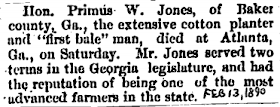Portrait courtesy of the Texas Legislative Reference Library.
Born of humble stock in Germany, Dethloff Willrodt migrated to the United States in the late 1850s to seek a new life, finding one in the vast expanses of Texas. During a life that extended nine decades, Willrodt saw action on both sides during the Civil War, learned the carpentry trade, became a successful farmer, and was elected to a term in the Texas House of Representatives. Although a picture of Willrodt has been located (along with other pieces of information vital to the construction of this article) little else could be found on his life, except a small biography in Volume 4 of the 1916 work A History of Texas and Texans by Francis White Johnson.
Dethloff Willrodt was born on January 19, 1840, in the village of Luetenberg, located in the Duchy of Holstein in Germany. Willrodt was the sixth of seven children born to farmer Dethloff Willrodt (died 1857) and his wife Margaret Herbst (died 1845). Willrodt and his siblings attended schools native to Holstein and upon reaching adolescence were encouraged by their father to seek out a new life in America.
Inspired by his father's words, Willrodt began on his path to the United States in 1859, embarking from a port in Hamburg and after a few weeks reached New York. Soon after he began a trek to the county of Macoupin, Illinois to live with relatives. His Illinois residency lasted about a year, and he eventually moved from Macoupin County to Texas, where his brother Ernst had immigrated some years previously. Once settled, Willrodt began learning the carpentry trade whilst also studying at a private school to learn the English language.
Willrodt's migration to Texas came at a time when the seeds of secession were being sown in the South, and in February 1861 Texas became the seventh state to secede from the Union. Although opposed to slavery and secession, Willrodt wasn't exempt from the Confederate Conscription Act passed in April 1862. With this act (the first draft in American history) Willrodt and others of his age group basically "volunteered" for service in the Confederate ranks, with our subject being assigned to Waul's Texas Legion, under the command of Col. Thomas Neville Waul (1813-1903). This outfit was eventually deployed to Mississippi, and, by a stroke of luck, Willrodt never saw armed combat as a Confederate soldier, as he was taken prisoner by the Union Army at Oxford, Mississippi.
After his capture, Willrodt and other soldiers were sent North to Cairo, Illinois, where they were "given the opportunity to enlist in the Union Army." Not passing up the opportunity to do so, Willrodt enlisted in the Twelfth Illinois Cavalry and subsequently saw action at the Battle of Brandy Station as well as the Battle of Gettysburg. The Twelfth Illinois later was sent to New Orleans and then Texas, where Willrodt was mustered out of service on December 20, 1865. After returning from the war front, Willrodt settled in the city of Bellville in Austin County, Texas, and began a career as a farmer.
From an 1866 Illinois Adjutant General's Report.
On February 4, 1869, Willrodt married in Bellville to another German immigrant, Ms. Elizabeth Waak (1848-1916), originally of Mecklenburg. This union eventually produced several children, who are listed as follows in order of birth: William (1869-1949, later a prominent local merchant), Heinrich (1871-1884), Herman (1874-1941), Ernst (1876-1960), Alma (died in infancy in 1878), Minna (birth-date unknown), Max (1880-1913), Richard D. (1892-1975) and Meta (1893-1984).
During the latter half of the 19th century, Dethloff Willrodt found success as a farmer in Austin County, owning over 200 acres of land by 1884. The 1916 History of Texas and Texans notes that he also followed the carpenter's trade and gave special attention to growing corn and cotton on his property while also raising stock. This work also denotes that he was the primary organizer of the Mercantile Company of Bellville, as well as holding stock in the company.
Around the same time as his involvement with the aforementioned mercantile company, Willrodt began treading the political waters, being elected as a county commissioner for Austin County from the First District. In 1898 he won a term in the Texas State House of Representatives from Bellville, serving in the legislative session of 1899-1901. His service here saw him sit on two house committees, those being Penitentiaries and Public Buildings and Grounds, and his house service is marked by the History of Texas and Texans as that of a "sterling representative, and put himself behind all useful and practical legislation enacted during that term." A roster from the Texas Legislative Manual of 1899 is shown below, bearing Willrodt's abbreviated name.
In the years following his one term in the legislature, Willrodt continued to be involved in various aspects of public service, helping to establish a rural mail delivery through Bellville and helped in formulating a new form of telephone system for the community. In August 1916 Elizabeth Waak Willrodt died at age 68 after over forty years of marriage and was buried in the Coshatte Cemetery in Austin County. Willrodt didn't remarry following her death and though advanced in years continued an active schedule, being a member of the local Lutheran church as well as maintaining an honorary membership in the Sons of Hermann fraternal organization.
Dethloff Willrodt celebrated his 90th birthday in 1930 and died two years later on June 12, 1932, in Coshatte, Texas. His life had spanned from humble beginnings as a child in Germany to Texas statehood, to the Civil War battlefield to the presidency of Herbert Hoover. Following his death, Willrodt was interred at the Coshatte Cemetery in Austin County, Texas alongside his wife Elizabeth, who had predeceased him over a decade earlier.












